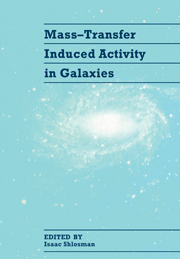Book contents
- Frontmatter
- Contents
- Preface
- List of Participants
- I INTRODUCTION
- II THE INNER PARSEC
- III THE CIRCUMNUCLEAR REGION
- IV GAS DYNAMICS AND STAR FORMATION IN BARRED AND NORMAL GALAXIES
- V NUCLEAR GAS AND LARGE-SCALE PROPERTIES OF AGN AND STARBURST HOSTS
- VI HOST GALAXY-AGN-NUCLEAR STARBURST CONNECTION
- VII GALAXY INTERACTIONS AND INDUCED ACTIVITY
- VIII GAS DYNAMICS IN ELLIPTICALS
- IX AGN AND STARBURST HOSTS AT LARGE REDSHIFTS
- Early AGN and Galaxy Formation (Invited paper)
- Collapses, Collisions, Quasars, and Cosmogony (Invited paper)
- The Evolution of Quasar Host Galaxies
- Evolution of the Galaxy Merger Rate: Counting Pairs in HST Fields (Poster paper)
- Stellar Mass Loss in Ellipticals and the Fueling of AGN (Poster paper)
- Star–Forming Galaxies and Large–Scale Structure (Poster paper)
- X CONFERENCE SUMMARY
- Subject Index
- Object Index
- Author Index
Star–Forming Galaxies and Large–Scale Structure (Poster paper)
Published online by Cambridge University Press: 05 May 2010
- Frontmatter
- Contents
- Preface
- List of Participants
- I INTRODUCTION
- II THE INNER PARSEC
- III THE CIRCUMNUCLEAR REGION
- IV GAS DYNAMICS AND STAR FORMATION IN BARRED AND NORMAL GALAXIES
- V NUCLEAR GAS AND LARGE-SCALE PROPERTIES OF AGN AND STARBURST HOSTS
- VI HOST GALAXY-AGN-NUCLEAR STARBURST CONNECTION
- VII GALAXY INTERACTIONS AND INDUCED ACTIVITY
- VIII GAS DYNAMICS IN ELLIPTICALS
- IX AGN AND STARBURST HOSTS AT LARGE REDSHIFTS
- Early AGN and Galaxy Formation (Invited paper)
- Collapses, Collisions, Quasars, and Cosmogony (Invited paper)
- The Evolution of Quasar Host Galaxies
- Evolution of the Galaxy Merger Rate: Counting Pairs in HST Fields (Poster paper)
- Stellar Mass Loss in Ellipticals and the Fueling of AGN (Poster paper)
- Star–Forming Galaxies and Large–Scale Structure (Poster paper)
- X CONFERENCE SUMMARY
- Subject Index
- Object Index
- Author Index
Summary
ABSTRACT
From the preliminary analysis of a sample of ≃ 600 galaxies with bj ≤ 19.4, and spanning a redshift interval up to z ≃ 0.3, we deduce that star formation per unit luminosity, as indicated by the OII 3727 line equivalent width, is a function of galaxy luminosity (decreasing at increasing luminosities), redshift (increasing at increasing redshift, or, physically, look–back time) and environment.
INTRODUCTION
At the ESO 3.6m telescope at La Silla, we are currently performing a redshift survey of galaxies with bj ≤ 19.4, in a rectangular area ≃ 22° × 1° (plus a nearby area of ≃ 5° × 1°) in a region around the South Galactic Pole. Up to now we have acccumulated spectra for ≃ 2,000 galaxies over ≃ 70% of the area.
The distribution in distance of the survey galaxies exibits significative peaks above the expectation at D ≃ 180h-1 Mpc and D ≃ 300h-1 Mpc. These peaks correspond to large scale structures extending over a significant fraction of the strip.
A large fraction of galaxies (≃ 40%) shows the presence of one or more emission lines (OII λ3727, Hβ, OIII λλ4959,5007). These objects can be either spiral galaxies, where lines originate mostly from HII regions in the disks, or galaxies undergoing a significant burst of star formation. The observed peaks in the galaxy distribution are much less pronounced when only emission line galaxies are considered. This suggests that either spiral galaxies are less frequent in the densest regions, thus confirming a large scale validity of the well known morphology–density relation, or starburst phenomena in galaxies occur preferentially in low density environments, or both.
- Type
- Chapter
- Information
- Mass-Transfer Induced Activity in Galaxies , pp. 487 - 488Publisher: Cambridge University PressPrint publication year: 1994

